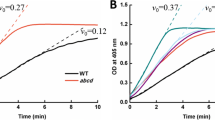Abstract
The thermostability of the methyl parathion hydrolase (MPH_OCH) from Ochrobactrum sp. M231 was improved using site-directed mutagenesis. Two prolines (Pro76 and Pro78) located on the protein surface were selected for mutations after inspection of the sequence alignment of MPH_OCH and OPHC2, a thermostable organophosphorus hydrolase from Pseudomonas pseudoalcaligenes C2-1. The temperature of the double-point mutant (P76D/P78K) at which the mutant lost 50% of its activity (T50) was approximately 68 °C, which is higher than that of WT enzyme (64 °C), P76D (67 °C), and P78K (59 °C). Structural analysis of P76D/P78K indicated that the substituted residues (Asp76 and Lys78) could generate an ionic bond and increase the structural electrostatic energy, which could then increase the stability of the protein. These results also suggest that the thermal stability of proteins could be improved by adding the ionic bond on protein surface.




Similar content being viewed by others
References
Brooks, B. R., Brooks, C. L., 3rd, Mackerell, A. D., Jr., Nilsson, L., Petrella, R. J., Roux, B., et al. (2009). Charmm: the biomolecular simulation program. Journal of Computational Chemistry, 30(10), 1545–1614.
Chen, J., Brooks, C. L., 3rd, & Khandogin, J. (2008). Recent advances in implicit solvent-based methods for biomolecular simulations. Current Opinion in Structural Biology, 18(2), 140–148.
Chu, X., Wu, N., Deng, M., Tian, J., Yao, B., & Fan, Y. (2006). Expression of organophosphorus hydrolase ophc2 in Pichia pastoris: purification and characterization. Protein Expression and Purification, 49(1), 9–14.
Chu, X., Tian, J., Wu, N., & Fan, Y. (2010). An intramolecular disulfide bond is required for the thermostability of methyl parathion hydrolase, ophc2. Applied Microbiology and Biotechnology, 88(1), 125–131.
Cui, Z., Li, S., & Fu, G. (2001). Isolation of methyl parathion-degrading strain m6 and cloning of the methyl parathion hydrolase gene. Applied and Environmental Microbiology, 67(10), 4922–4925.
Dong, Y., Bartlam, M., Sun, L., Zhou, Y., Zhang, Z., Zhang, C., et al. (2005). Crystal structure of methyl parathion hydrolase from Pseudomonas sp. Wbc-3. Journal of Molecular Biology, 353(3), 655–663.
Gribenko, A. V., Patel, M. M., Liu, J., McCallum, S. A., Wang, C., & Makhatadze, G. I. (2009). Rational stabilization of enzymes by computational redesign of surface charge–charge interactions. Proc Natl Acad Sci, 106(8), 2601–2606.
Li, W., Zhou, X., & Lu, P. (2005). Structural features of thermozymes. Biotechnology Advances, 23(4), 271–281.
Liu, H., Zhang, J. J., Wang, S. J., Zhang, X. E., & Zhou, N. Y. (2005). Plasmid-borne catabolism of methyl parathion and p-nitrophenol in Pseudomonas sp. strain wbc-3. Biochemical and Biophysical Research Communications, 334(4), 1107–1114.
Pack, S. P., & Yoo, Y. J. (2004). Protein thermostability: structure-based difference of amino acid between thermophilic and mesophilic proteins. Journal of Biotechnology, 111(3), 269–277.
Palackal, N., Brennan, Y., Callen, W. N., Dupree, P., Frey, G., Goubet, F., et al. (2004). An evolutionary route to xylanase process fitness. Protein Science, 13(2), 494–503.
Perl, D., Mueller, U., Heinemann, U., & Schmid, F. X. (2000). Two exposed amino acid residues confer thermostability on a cold shock protein. Nature Structural Biology, 7(5), 380–383.
Polizzi, K. M., Bommarius, A. S., Broering, J. M., & Chaparro-Riggers, J. F. (2007). Stability of biocatalysts. Current Opinion in Chemical Biology, 11(2), 220–225.
Sambrook, J., & Russell, D. W. (2001). Molecular cloning: a laboratory manual (3rd ed.). Cold Spring Harbor: Cold Spring Harbor Laboratory.
Sterner, R., & Liebl, W. (2001). Thermophilic adaptation of proteins. Critical Reviews in Biochemistry and Molecular Biology, 36(1), 39–106.
Tian, J., Wang, P., Gao, S., Chu, X., Wu, N., & Fan, Y. (2010). Enhanced thermostability of methyl parathion hydrolase from Ochrobactrum sp. M231 by rationally engineering a glycine to proline mutation. FEBS Journal, 277, 4901–4908.
Tian, J., Wu, N., Chu, X., & Fan, Y. (2010). Predicting changes in protein thermostability brought about by single- or multi-site mutations. BMC Bioinformatics, 11, 370.
Van den Burg, B., Dijkstra, B. W., Vriend, G., Van der Vinne, B., Venema, G., & Eijsink, V. G. (1994). Protein stabilization by hydrophobic interactions at the surface. European Journal of Biochemistry/FEBS, 220(3), 981–985.
Wei, M., Zhang, J. J., Liu, H., Wang, S. J., Fu, H., & Zhou, N. Y. (2009). A transposable class I composite transposon carrying mph (methyl parathion hydrolase) from Pseudomonas sp. strain wbc-3. FEMS Microbiology Letters, 292(1), 85–91.
Xiao, W., Chu, X., Tian, J., Guo, J., & Wu, N. (2008). Cloning of a methyl parathion hydrolase gene from Ochrobactrum sp. (in Chinese). Journal of Agricultural Science and Technology, 10(S1), 99–102.
Yang, C., Liu, N., Guo, X., & Qiao, C. (2006). Cloning of mpd gene from a chlorpyrifos-degrading bacterium and use of this strain in bioremediation of contaminated soil. FEMS Microbiology Letters, 265(1), 118–125.
Yang, C., Freudl, R., Qiao, C., & Mulchandani, A. (2010). Cotranslocation of methyl parathion hydrolase to the periplasm and of organophosphorus hydrolase to the cell surface of Escherichia coli by the tat pathway and ice nucleation protein display system. Applied and Environmental Microbiology, 76(2), 434–440.
Yu, H., Yan, X., Shen, W., Hong, Q., Zhang, J., Shen, Y., et al. (2009). Expression of methyl parathion hydrolase in Pichia pastoris. Current Microbiology, 59(6), 573–578.
Acknowledgments
This work was supported by grants from National High Technology Research and Development Program of China (863 Program, 2007AA100605).
Author information
Authors and Affiliations
Corresponding author
Additional information
Yidan Su and Jian Tian contributed equally to this work.
Electronic supplementary materials
Below is the link to the electronic supplementary material.
Table S1
Primers used in this study (DOC 30.5 kb)
Rights and permissions
About this article
Cite this article
Su, Y., Tian, J., Wang, P. et al. Improving the Thermostability of a Methyl Parathion Hydrolase by Adding the Ionic Bond on Protein Surface. Appl Biochem Biotechnol 165, 989–997 (2011). https://doi.org/10.1007/s12010-011-9314-z
Received:
Accepted:
Published:
Issue Date:
DOI: https://doi.org/10.1007/s12010-011-9314-z




